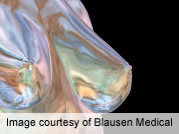healthnewslink
Women's Newsletter
January 30, 2012 |
| In this Issue |
|
|
|
|
Caffeine May Alter Women's Estrogen Levels
But effect is different in Asians, whites, study says
 THURSDAY, Jan. 26 (HealthDay News) -- Caffeine changes women's estrogen levels and has different effects in Asian and white women, a new study says.
More than 250 women, ages 18 to 44, took part in the study between 2005 and 2007. On average, they consumed 90 milligrams of caffeine a day, about the equivalent of one cup of caffeinated coffee.
Estrogen is the reproductive hormone produced by the ovaries.
Asian women who consumed an average of 200 milligrams or more of caffeine a day (equivalent to about two cups of coffee) had elevated estrogen levels compared to women who consumed less. But white women who consumed the same amount of caffeine had slightly lower estrogen levels than women who consumed less.
Black women who consumed 200 or more milligrams of caffeine daily had elevated estrogen levels, but this finding was not statistically significant, said the U.S. National Institutes of Health researchers and their colleagues.
The caffeine consumed by the women in the study came from any of these sources: coffee, black tea, green tea and caffeinated soda. The findings differed slightly when the researchers considered the source of caffeine individually.
Consuming 200 milligrams of caffeine from coffee mirrored the overall findings. But consumption of more than one cup each day of caffeinated soda or green tea was associated with higher estrogen in all three groups of women, according to the study published online in the February issue of the American Journal of Clinical Nutrition.
The caffeine-related changes in estrogen levels did not appear to affect women's ovulation, said the researchers, who followed the women for up to two menstrual cycles.
About 89 percent of U.S. women ages 18 to 34 consume the caffeine equivalent of 1.5 to two cups of coffee a day, according to the authors.
"The results indicate that caffeine consumption among women of child-bearing age influences estrogen levels," Enrique Schisterman, of the Division of Epidemiology, Statistics and Prevention Research at the U.S. National Institute of Child Health and Human Development, said in an NIH news release.
"Short term, these variations in estrogen levels among different groups do not appear to have any pronounced effects. We know that variations in estrogen level are associated with such disorders as endometriosis, osteoporosis, and endometrial, breast and ovarian cancers. Because long-term caffeine consumption has the potential to influence estrogen levels over a long period of time, it makes sense to take caffeine consumption into account when designing studies to understand these disorders," Schisterman said.
More information
Health Canada has more about caffeine  . .

|
Women Can Take Steps to Prevent Cervical Cancer
Regular Pap tests, HPV vaccine go a long way in warding off the disease, experts say
 WEDNESDAY, Jan. 25 (HealthDay News) -- Women need to get recommended Pap tests, while girls and young women should be vaccinated against human papillomavirus (HPV) to protect them from cervical cancer, the American College of Obstetricians and Gynecologists advises during Cervical Health Awareness Month.
Cervical cancer kills more than 4,000 women in the United States each year. Many of them could have been saved by routine Pap tests, which look for abnormal cells in the cervix that can turn into cancer. When caught early, those abnormal cells are highly treatable, according to the college.
More than 12,000 new cases of cervical cancer will be diagnosed in the United States this year, according to the American Cancer Society.
The good news is that the rate of cervical cancer in the United States has fallen more than 50 percent in the past three decades due to the widespread use of the Pap test, the college says.
Cervical cancer is caused by certain strains of HPV, a common sexually transmitted disease. HPV can also cause genital and anal warts and cancer of the mouth, head and neck, penis and anus.
Women can help protect themselves against cervical cancer by being monogamous, practicing safe sex and getting periodic Pap tests. In addition, girls and young women aged 9 to 26 should receive the HPV vaccine, the college recommends.
A young women should get her first Pap test when she turns 21 and continue having a Pap test every two years until age 30. Women age 30 and beyond who have three consecutive negative Pap test results can be screened once every three years, the college says.
More information
The U.S. National Cancer Institute has more about cervical cancer prevention.

|
Ob-Gyns Should Screen for Domestic Abuse: Experts
Intimate partner violence can be psychological or physical, occurs at all levels of society

TUESDAY, Jan. 24 (HealthDay News) -- Obstetricians and gynecologists should screen all patients for intimate partner violence, including during prenatal visits, according to new recommendations from the American College of Obstetricians and Gynecologists.
In addition, ob-gyns should offer patients support, and have referral and resource information on hand to give to patients who are victims of abuse.
Intimate partner violence includes physical injury, psychological abuse, sexual assault, progressive isolation, stalking, deprivation, intimidation and reproductive coercion. The goal of these behaviors is to establish control over a partner.
The violence can occur among both heterosexual and same-sex partners and at every level of society, regardless of age, gender, income levels, race, ethnicity, religion or educational background, according to a news release from the college.
About one in four women has been physically and/or sexually assaulted by a current or former partner, and nearly 324,000 pregnant women are abused by their partners each year in the United States, researchers have found.
Intimate partner violence has been linked to poor pregnancy outcomes, including poor weight gain, infection, fetal injury, preterm delivery, low birth weight and stillbirth.
Signs and symptoms that a woman is experiencing violence include physical injuries, chronic headaches, chronic pelvic pain, irritable bowel syndrome, and recurrent vaginal infections. Violence is often linked to depression, anxiety, substance abuse, unintended pregnancy and suicide.
"Women of all ages experience intimate partner violence, but it is most prevalent among reproductive-age women," Dr. Maureen Phipps, chair of the college's Committee on Health Care for Underserved Women, said in the news release. "We have a prime opportunity to identify and help women who are being abused by incorporating this screening into our routine office visits with each and every patient."
The recommendations are published in the February issue of the journal Obstetrics & Gynecology.
More information
The American Academy of Family Physicians has more about domestic violence  . .

|
New Genetic Clues to Breast Cancer?
Researchers say they've identified three more genomic regions associated with the disease

SUNDAY, Jan. 22 (HealthDay News) -- Researchers have identified three new genomic regions they believe are linked with breast cancer that may help explain why some women develop the disease.
All three newly identified areas "contain interesting genes that open up new avenues for biological and clinical research," said researcher Douglas Easton, a professor of genetic epidemiology at the University of Cambridge in England.
Breast cancer is the most common cancer among women, with about 1 million new cases annually worldwide and more than 400,000 deaths a year.
Scientists conducting genome-wide association studies -- research that looks at the association between genetic factors and disease to pinpoint possible causes -- had already identified 22 breast cancer susceptibility loci. Locus is the physical location of a gene or DNA sequence on a chromosome.
"The three [newly identified] loci take the number of common susceptibility loci from 22 to 25," said Easton.
However, the three new susceptibility loci might explain only about 0.7 percent of the familial risks of breast cancer, bringing the total contribution to about 9 percent, the researchers said.
Michael Melner, scientific program director for the American Cancer Society, said this current research adds some important new clues to existing evidence, but he agreed that the number of cases likely associated with these three variants is probably low.
"So the total impact in terms of patients would be fairly small," Melner said.
The study is published online Jan. 22 in Nature Genetics.
To find the new clues, Easton's team worked with genetic information on about 57,000 breast cancer patients and 58,000 healthy women obtained from two genome-wide association studies.
The investigators zeroed in on 72 different single nucleotide polymorphisms (SNPs). A SNP -- pronounced "snip" -- is a change in which a single base in the DNA differs from the usual base. The human genome has millions of SNPs, some linked with disease, while others are normal variations.
The researchers focused on three SNPs -- on chromosomes 12p11, 12q24 and 21q21.
Easton's team found that the variant on the 12p11 chromosome is linked with both estrogen receptor-positive breast cancer (which needs estrogen to grow) and estrogen receptor-negative breast cancer. The other two variants are only linked with ER-positive cancers, they said.
One of the newly identified variants is in an area with a gene that has a role in the development of mammary glands and bones. Easton said it was already known that mammary gland development in puberty is an important period in terms of determining later cancer risk. "But these are the first susceptibility genes to be shown to be involved in this process," he said.
One of the other SNPs is in an area that can affect estrogen receptor signaling, the researchers found.
Melner, noting some of the research is "fine tuning" of other work, said in his view the new understanding of the signaling pathways and their genetic links is the most important finding.
"When you delineate a pathway, you bring up new potential targets for therapy," he said. "The more targets you have, you open up the potential for having multiple drugs and attacking a cancer more easily, without it becoming more resistant."
Overall, Melner added, the results underscore the complexity of the different mechanisms involved in breast cancer development.
More information
For more about the genetics of breast cancer, visit the American Cancer Society  . .

|
| Copyright © 2012 ScoutNews, LLC. All rights reserved. |
|